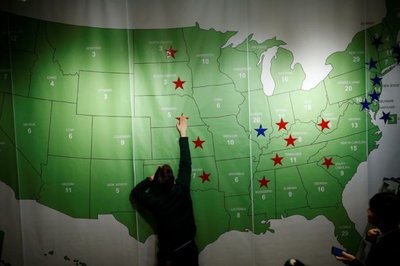For a Google version of this lesson plan, click here. (Note: you will need to make a copy of the document to edit it).
To explore the rest of Classroom's Invention Education lesson series, click here . We are always looking for ways to make our invention resources stronger. If you completed part or all of this lesson, we would appreciate it if you filled out this feedback form.
Overview
Imagine a Toyota Camry weighing 3,595 pounds rolling slowly down a driveway towards an unsuspecting beetle that weighs 39,000 times less than the rolling car. This particular beetle, known as a diabolical ironclad beetle, is moving as fast as it can as the car’s tire approaches. Unfortunately, the beetle gets squashed. But, amazingly, the car passes and the beetle picks itself up and continues on its journey.
Essential questions
- How was the diabolical ironclad beetle able to survive such a massive impact?
- How can you use the diabolical ironclad beetle’s characteristics to help you design a new super tough bicycle helmet?
Estimated time
One or two 50-minute class periods (Note: If you have limited time and resources, you can work through the sketch/design phase only).
Subjects
Science, engineering, technology, biology
Grades
6-12
Objectives
- Learn how a beetle’s exoskeleton will protect it from extreme pressure and crushing blows.
- Explore biomimicry, and the ways inventions that solve everyday problems can be inspired by nature.
- Design a rapid prototype of your “beetle” bike helmet invention. If you complete the lesson in full, you will build and test the prototype as well.
- Communicate how your invention was inspired by the diabolical ironclad beetle and how your helmet functions.
Materials
- Internet access
- Paper and pencil
- A ball or small object that can serve as a test subject. This could be anything from a ping-pong ball to small fruit to a wadded up piece of paper to a tennis ball.
- Cereal box or thin cardboard box
- Roll of masking tape (or substitute tape)
- Scissors that will cut cardboard
Vocabulary
- biomimicry: innovation or invention inspired by natural adaptations. Some examples include velcro, which was inspired by plant burrs that stick to fur and clothing, and some types of glues that were inspired by the sticky feet of geckos.
- elytra: a beetle’s shell, in many cases protecting wings
Warm-up activity
Read this short PBS NewsHour article, Can’t crush this: Beetle armor gives clues to tougher planes, to learn about a special beetle and it’s protective shell:
Watch the following video on the diabolical ironclad beetle, The Engineering Secrets of the World's Toughest Beetle.
Learn about bicycle helmets injuries statistics from the U.S. Department of Transportation.
Main activity
Part one
Taking the information from the the resources provided above:
- Use a ball or other small object to serve (no pun intended) as a bicycle rider’s head. Use whatever is available and can be reused or replaced for repeated testing. If time or resources are limited, skip this step and focus on the design and discussion stage.
- Draw a sketch of how the ironclad beetle shell works. You may first want to write down what you observed (observation = what you saw demonstrated as the beetle is crushed) and what you can infer from that observation (inference = guesses about how and why what you observed works).
- Draw a design of your inventive bicycle helmet, based on what you learned about the diabolical ironclad beetle.
- In groups or as a class, discuss designs and ways to improve them.
Part two
- Fabricate your inventive bicycle helmet using cut cardboard and tape.
- Test your invention by mounting your helmet on the chosen ball or small object and applying pressure with your hand.
- Teachers may also introduce some other means of testing the efficacy of the helmets, including increasing weight to the object or dropping the object from increasing heights. Also consider recording impact in slow-mo video on a camera phone as a way of testing impact.
- Your invention will have a failure point where too much pressure will cause the ball to flatten or squish.
- Using the data you collected in step two, return to your design and sketch it again with improvements. If there is time, you can rebuild and retest your design to see if it’s more effective with your modifications.
Wrap-up
Share it out! Present your invention to your class or potential interested parties (i.e. your principal, city councilmember, businessperson, non-profit organization, etc.) Then have your teacher share a photo of the invention (photos of sketches/drawing are welcome!) using #PBSInvention on Twitter @NewsHourExtra or email the photo and a comment about your invention to education@newshour.org and we will share it for you! You may want to check out Invention Convention to see about entering your invention in this program.
Additional resources
- Take a look at this NewsHour Classroom lesson plan: How mimicking nature inspires new inventions
- Learn more about diabolical ironclad beetles .
- To learn more about invention education, visit InventEd.org and watch this video here .
Learn more about biomimicry and forms of biomimicry in inventions:
Doug Scott teaches Robotics and Information Technology at Hopkinton High School in Massachusetts. In 2020, Doug was awarded the Presidential Award for Excellence in Mathematics and Science Teaching. Doug’s long teaching career sprung from his hockey coaching experiences, which have been instrumental in helping him motivate students through the inventing processes. Doug and the Natick High School InvenTeam participated in the Lemelson-MIT Program’s EurekaFest in 2013. In the spring of 2014, Doug accompanied two student representatives from Natick to the fourth White House Science Fair. Just a few years later, their invention was awarded U.S. Patent 20,140,360,420. He continues to be an advocate for invention education for all. You can reach Doug Scott at mrscottbot.org and @mrscottbot.
Fill out this form to share your thoughts on Classroom’s resources. Sign up for NewsHour Classroom’s ready-to-go Daily News Lessons delivered to your inbox each week.






